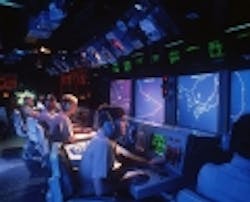Navy taps three radar giants to develop future multiband radar to defend against aircraft and missiles
WASHINGTON, 1 Oct. 2010. the U.S. Navy is asking three of the nation's most prominent radar systems integration companies to develop technology for a future multiband radar system able to provide volume search, tracking, ballistic missile defense discrimination, and missile communications, as well as horizon search, precision tracking, and terminal illumination.
The three military radar companies -- the Northrop Grumman Systems Corp. Electronic Systems segment in Linthicum Heights, Md.; the Lockheed Martin Corp. Mission Systems and Sensors (MS2) segment in Moorestown, N.J.; and the Raytheon Co. Integrated Defense Systems segment in Sudbury, Mass. -- will develop technology for the future Air and Missile Defense Radar (AMDR) -- a radar suite containing an S-band radar, an X-band radar, and radar suite controller (RSC) that will be scalable to accommodate current and future mission requirements for several kinds of Navy weapons platforms.
The AMDR S-band radar (AMDR-S) will provide volume search, tracking, ballistic missile defense discrimination and missile communications, while the AMDR X-band radar (AMDR-X) will provide horizon search, precision tracking, missile communication, and terminal illumination.
Northrop Grumman is receiving a $120 million contract, Lockheed Martin is receiving a $119.2 million contract, and Raytheon is receiving a $112.3 contract to develop technology for the AMDR S-band and radar suite controller. The RSC will perform all coordination actions to ensure that both radars operate in concert in a widely diverse environment.
Officials of the U.S. Naval Sea Systems Command in Washington awarded the contracts Thursday. For more information contact Naval Sea Systems Command online at www.navsea.navy.mil, Northrop Grumman Electronic Systems at www.es.northropgrumman.com, Lockheed Martin MS2 at www.lockheedmartin.com/ms2, or Raytheon Integrated Defense at www.raytheon.com.
